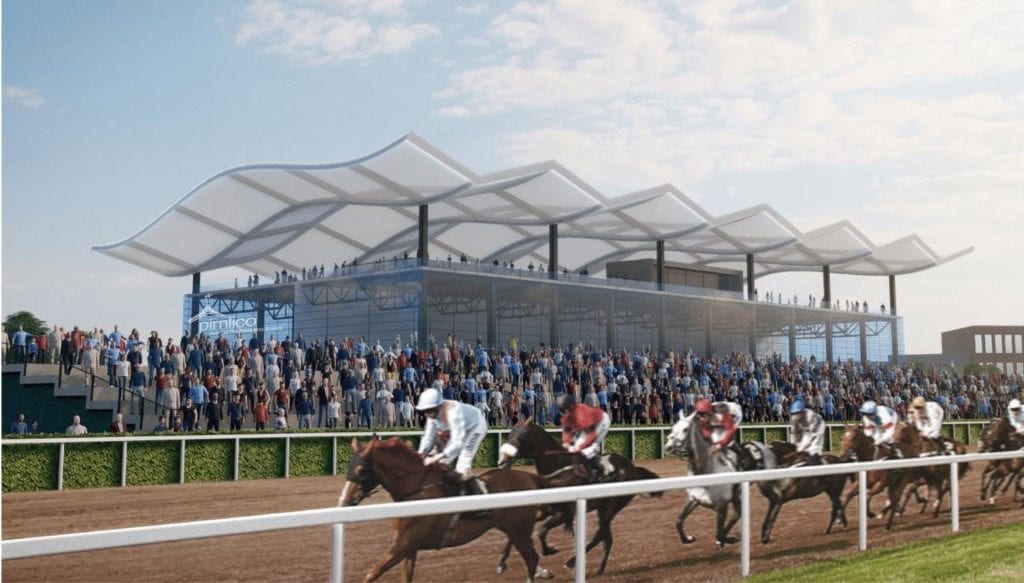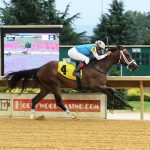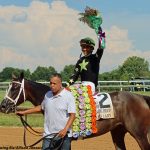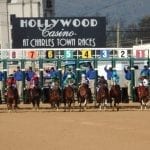“SKILL, COURAGE AND LUCK”: HOW THE PIMLICO DEAL CAME TOGETHER

In 2020 the Maryland General Assembly passed legislation that will keep the Preakness in Baltimore in a significantly modernized Pimlico, while also taking steps to revitalize the Park Heights neighborhood of which Pimlico is a part and providing for the overhaul of Laurel Park. That legislation grew out of behind-the-scenes negotiations involving the city, the Stronach Group, and others. This is the story of how those negotiations led to the deal.
In the weeks after the 2019 Maryland legislative session, Alan Rifkin had a problem.
Make that two problems. Rifkin is an attorney who for years has worked for the Maryland Jockey Club (MJC), now owned by the Stronach Group. On the one hand, his client’s efforts to obtain state support for a so-called “super-track” at Laurel Park – which would have left Pimlico out in the cold — had blown up spectacularly, leaving recriminations and anger in their wake.
- Edy’s Flame heats up in first CT 2yo race
 Edy’s Flame dominated Charles Town’s first 2yo race of the year, a somewhat surprising result even if bettors focused on the right connections.
Edy’s Flame dominated Charles Town’s first 2yo race of the year, a somewhat surprising result even if bettors focused on the right connections.
On the other, Baltimore City, under the leadership of then-Mayor Catherine Pugh, had filed suit, seeking to take possession of the Pimlico property and the MJC’s most valuable asset, the Preakness.
And even though Rifkin – like many legal analysts — was confident that his client would prevail in a court of law, where would that leave the MJC?
He needed the company and the city to put down their swords and start talking again. But how?
It’s then that fate intervened. On May 2 of that year – two days before the Kentucky Derby and 16 days before the Preakness would be held in front of a partially condemned grandstand – the mounting legal troubles of Mayor Pugh’s scandal-plagued administration finally boiled over.
She resigned, which elevated City Council President Jack Young to Mayor – and created an opening.
It was the first in a handful of fortuitous moments that helped Rifkin and others – including Alan Foreman, general counsel to the Maryland Thoroughbred Horsemen’s Association; Bill Cole, formerly head of the Baltimore Development Corporation; horse owner and breeder Anthony Manganaro, who served as a kind of unpaid consultant to the city; and former Maryland Jockey Club owner Joe De Francis – break the seemingly impregnable logjam around the future of Pimlico.
“If you think about it,” Manganaro said later, “you do need skill. You do need luck. And you need courage, right?”
The deal that the men crafted is a complex one. It involves the issuance of $375 million in bonds by the Maryland Stadium Authority, permanent and temporary property transfers, and dramatic changes, in particular, to the Pimlico site.
When the dust has cleared, the deal that cleared the legislature will keep the Preakness in Baltimore for decades to come, transform Laurel Park into what advocates hope will be a model modern racetrack, and to a significant extent, ensure the viability of the Thoroughbred industry here for the foreseeable future.
And it amply demonstrates Manganaro’s must-haves: the courage, to come up with a solution entirely unlike any that had been proposed before. The skill to put together a plan that the experts said was financially viable and the politicians stamped politically feasible.
And in several key moments, the kind of luck that Shakespeare had in mind when he wrote, “There is a tide in the affairs of men which, when taken at the flood, leads on to fortune.”
“When you think from start to finish, how tenuous I guess the roadway is to get from the beginning to the end,” is how Joe De Francis put it. De Francis, as it happens, was in the middle of the second good break the project needed.
While on a trip to Europe around the same time, he received a phone call. Seeing it was from a Baltimore area number, he decided to let it go to voicemail.
“And for whatever reason, I guess, because I was in Europe, the voicemail didn’t answer, the phone just rang and rang and rang and rang,” De Francis recalled. “So I finally picked it up. And it was a reporter from the Baltimore Sun, who wanted to ask me about the rebuild of Pimlico.”
A December 2018 Maryland Stadium Authority study had pegged the cost of a new Pimlico at more than $400 million – an amount that was beyond anyone’s imagining. With Preakness 2019 nearing – and the future of Pimlico no closer to resolution – the Sun wanted to hear from the track’s former owner what he thought of the proposal.
“I ran the place for 20 years; I know it pretty well,” De Francis said he told the reporter, Jeff Barker. “You don’t need to spend anywhere near $500 million rebuilding it in order to make it a worthy home for the Preakness. You could do it, literally, for less than half that.”
Instead, De Francis argued for essentially a modular Pimlico, one designed to house a brief, high-end meet. Laurel Park would be the workaday track, he suggested, home to year-round training, stabling and racing, while Pimlico would spring to life at Preakness time.
Barker’s article ran May 8, 2019 – six days after Pugh’s resignation and 10 days before the Preakness.
“Within the next 24 hours, I get two calls: one from Alan Rifkin and one from Anthony Manganaro,” said De Francis.
One call, in other words, from the Stronach Group, and one from its adversary, the City of Baltimore.
Calling De Francis’ comments “a really visionary interview,” Rifkin urged De Francis to contact Manganaro in an effort to get the City to withdraw its lawsuit. If that happened, he said, “I will pledge to do everything I can to see if I can get my client to sit down at the table with the city and explore options short of moving the Preakness to Laurel, conditioned on finding a solution to the facilities.”
Manganaro’s response was equally clear: “He’s right on. He’s saying exactly what we’re saying.”
De Francis had worked closely with both Rifkin, who’d been the MJC lawyer when De Francis owned the company, and Manganaro, particularly on the efforts to pass what eventually became the federal Horseracing Integrity and Safety Act.
That let him play a critical role as trusted broker between the city and the company. “Like Henry Kissinger kind of going between the two warring sides,” he said.
A few days later, at the Preakness, Mayor Young and Belinda Stronach chatted in the Stronach Group chalet. In a meeting both pregnant with possibility and fraught with peril, the sides inched closer together. Young agreed to a 90-day cooling off period in the legal proceedings; Stronach agreed to give Baltimore another look.
Young chose Cole, a self-described “recovering politician,” to be his lead negotiator. Rifkin asked Foreman to get involved to represent the horsemen and Thoroughbred industry.
The team was in place, and there was, as Rifkin put it, “A flicker of a candle of a chance that we could put the pieces together sufficiently to save the Preakness for Baltimore City, rebuild and modernize Pimlico, and rebuild and modernize Laurel.”
- Photo essay: D. Wayne Lukas retires
 The news that Hall of Fame trainer D. Wayne Lukas, gravely ill, would retire from training caught the racing world off-guard.
The news that Hall of Fame trainer D. Wayne Lukas, gravely ill, would retire from training caught the racing world off-guard.
Only a flicker, but it turned out to be enough. The “mutually assured destruction” approach of the legislative session gave way to partnership. Understanding that there could be no deal without the Preakness in Baltimore, no deal without redevelopment in the Park Heights neighborhood, no deal without a reinvigorated Laurel Park, no deal without year-round training and racing – knowing all of that, the sides became, in effect, each other’s advocates.
“The pieces really came together, but I spent as much time advocating for making certain that Laurel Park got the world class facility it needed after I got the Preakness, the commitment to keep the Preakness, as I ever did on anything else,” Cole said. “I knew that the only way this all works is if the Laurel Park solution accommodated the day-to-day Thoroughbred operation.”
Even so, they needed one last break. The deal they crafted had overwhelming support in the Legislature. It was all teed up – and then Covid-19 arrived.
A mad scramble managed to get the legislation through both houses on the last day of the legislative session. The bill was sent to Gov. Larry Hogan, who met it with… silence.
Rumors flew; he would veto the bill. The state’s increasingly strained finances wouldn’t bear the burden.
And then… more silence. The Governor must sign or veto bills within 30 days of their being presented to him; if he neither signs nor vetoes the bill, it becomes law without his signature.
As the 30th day dawned, racing industry members were a bundle of nerves. People who spoke with Hogan said that a veto was imminent.
But it never came. Hogan allowed the bill to become law without his signature. What changed his mind? There are different theories, but Hogan’s never said anything in public. Maybe it was just the good fortune that seemed to follow the project from beginning to end.
“I’ve always been a great believer in the wisdom of the philosophy of Yogi Berra,” De Francis said. “And one of his greatest pieces of wisdom was that it ain’t over ‘til it’s over. No one, I think, rested easy until the bill became law.”
“I didn’t sleep until [the bill became law],” Cole said. “I don’t know about everybody else, but I didn’t sleep until then.”
It’s several years from here to finished products, and not everyone is happy. Some are concerned about the plans for Pimlico – which involve rotating and shortening the track to open up other development opportunities – while others fret that this will put a lot of eggs in the Laurel basket, a concern that’s taken on new urgency in light of the recent closure of the track there.
But advocates argue that the deals embedded in this legislation give the Maryland Thoroughbred industry a level of assurance and confidence in the future that it hasn’t had in probably decades.
“All of a sudden, now, you’re going to end up with a brand-new industry here,” Foreman said. “It really ripples right through. I think we’ve all collectively invested in the future of the industry, and that’s going to be money well spent.”
NOTE: A longer and more detailed version of this article appeared in the May print edition of The Blood-Horse magazine. You can subscribe to The Blood-Horse here.
LATEST NEWS
















Although the plan was a revolutionary one, and it certainly brought a lot of things together, it has quite a few flaws. Especially now that Laurel has proven itself to be dangerously inadequate to support the bulk of MD racing. That track will continue to erode as soon as you fix it. And yet, a tried and true course, like Pimlico’s, will be destroyed for no reason other than to make money selling off historic land to developers and a an already sprawling hospital complex. As for the Stronach Group continuing to hold THEIR race there every year, at the cost of $10 million, a loophole in the law is just waiting to be used. ‘The Preakness must always be run at Pimlico unless there is an emergency or Pimlico ceases to exist.’ Scraping the landscape of every last vestige of old Hilltop’s history, fits that criteria very nicely. Don’t think that Stronach’s will do it? All they have to do is change their name again.The burning question is why does the destruction of the second oldest U.S. track, and a working one at that, the only way to help the neighborhood? Many neighbors want to still be a part of this historic site and have been for years. And they have heard all these promises before.
Laurel is sinking into the Swamp – Save Pimlico – Save the Preakness.